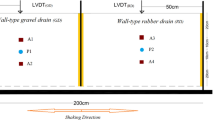Abstract
Due to the rising amount of waste rubber products, there is an urge to recycle these products and reduce waste disposal. Crumb rubber tyre in the sand decreases pore water pressure, creating a good drainage path and reducing liquefaction in saturated dense sand. This paper investigates the effect of the waste tyre and soil mixture (WTSM) layer around the piles in mitigating earthquake-induced liquefaction through finite element analysis in OpenSees platform. The effectiveness of this technique in reducing pile response is investigated through a parametric study with varied depth and thickness of the WTSM layer. It is estimated that a reduction in pile response is achieved with an increase in WTSM volume. It is also estimated that placing the same volume of WTSM layer depth-wise gives better control. Finally, for closely spaced piles WTSM mat of 1–1.5 m depth is proposed for liquefaction-induced pile damage control for buildings. Huge stock of scrap tyres may be used for pile response reduction due to liquefaction as recycling of waste tyre.











Similar content being viewed by others
Data Availability
Not applicable.
References
Presti DL (2013) Recycled tyre rubber modified bitumens for road asphalt mixtures: a literature review. Constr Build Mater 49:863–881
Shu X, Huang B (2014) Recycling of waste tire rubber in asphalt and Portland cement concrete: an overview. Constr Build Mater 67:217–224
Ahmed I, Lovell CW (1993) Use of rubber tires in highway construction. In: Utilization of waste materials in civil engineering construction, pp. 166–181.
D. Akbarimehr, and K. Fakharian, "Dynamic shear modulus and damping ratio of clay mixed with waste rubber using cyclic triaxial apparatus" Soil Dynamics and Earthquake engineering (2021), https://doi.org/10.1016/j.soildyn.2020.106435.
Rahman, G. A., Berthelot, C., Guenther, D., Olsen, S., McQuoid, T. (2011). “Laboratory Characterization of Shredded Tires as Substructure Road Drainage Layer Material”, Alberta, Transportation Association of Canada Edmonton.
Mittal RK, Gill G (2016) Recent developments in utilizing waste tires to reduce seismic earth pressures and liquefaction potential. International Journal of Advanced Structures and Geotechnical Engineering ISSN 2319–5347, Vol. 05, No. 03, July 2016.
Tsang HH (2008) (2008), Seismic isolation by rubber–soil mixtures for developing countries. Earthq Eng Struct Dyn 37(2):283–303. https://doi.org/10.1002/eqe.756
Nanda RP, Dutta S, Khan HA, Majumdar S (2018), Seismic protection of building by rubber soil mixture as foundation isolation, Int. J. Geotech. Earthq. Eng., 2018, Vol. 9, issue 1, DOI: https://doi.org/10.4018/IJGEE.2018010106.
Dutta S, Nanda RP (2021). Finite element analysis of rubber-soil mixture (RSM) for the pile response reduction under liquefaction, Arabian Journal of Geosciences (2021) 14:1729.
Bhattacharya S, Tokimatsu K (2013), Collapse of Showa Bridge revisited, Int J Geoeng Case Histories, 2013, 3(1), 24–35
Tokimatsu K, Mizuno H, Kakurai M (2021) Building damage associated with geotechnical problems, Soils and Foundations, 1996, 36, 219–234
Akbarimehr D, Aflaki E (2018) An experimental study on the effect of tire powder on the geotechnical properties of clay soils. Civ Eng J, 2018;4(3):594–601. https://doi.org/10.28991/cej-0309118.
Akbarmehri D, Eslami A, Aflaki E (2020) Geotechnical behaviour of clay soil mixed with rubber waste. J Clean Prod 2020:122632. https://doi.org/10.1016/j.jclepro.2020.122632
Santoni L, Webster L (2001) Airfields and road construction using fiber stabilization of sands, JTrans Eng, 2001. ASCE 127:96–104
Janalizadeh, A., Zahmatkesh, A., 2015. Lateral response of pile foundations in liquefiable soils. Rock mechanics and geotechnical engineering, 2015, https://doi.org/10.1016/j.jrmge. 2015.05.001
Gallagher PM, Pamuk A (2007) Abdoun T (2007), Stabilization of liquefiable soils using colloidal silica grout. J Mater Civ Eng 19(1):33–40
Otsubo M, Towhatab I, Hayashidac T, Liub B, Goto S (2016), Shaking table tests on liquefaction mitigation of embedded lifelines by backfilling with recycled materials foundations, Soil Found , 2016, 65(3):365–378
Kawata S, Hyodo M, Orense RP, Yamada S, Hazarika H (2008), Undrained and drained shear behavior of sand and tire chips composite material, In: Proceedings of the international workshop on scrap tire derived geomaterials opportunities and challenges, IW-TDGM, 2008, 277–283.
Zahmatkesh A (2019) Numerical analysis of pile foundation in liquefiable soils: parametric study. Int. J Geotech. Eng, 2019 DOI: https://doi.org/10.1080/19386362.2019.1684655
Vytiniotis A (2012) Contributions of the Analysis and Mitigation of Liquefaction in Loose Sand Slopes. Ph.D. Thesis, School of Civil and Environmental Engineering, Massachusetts of Technology. https://doi.org/10.1094/PDIS-11-11-0999-PDN.
Cubrinovski M, Ishihara K (2004) Simplified method for analysis of piles undergoing lateral spreading in liquefied soils. Soils Found 44(5):119–133
Funding
No funding.
Author information
Authors and Affiliations
Contributions
All authors contributed to the study conception and design. Data collection and analysis were performed by SD. The first draft of the manuscript was written by SD. Analytical investigation, methodology and original writing were completed by SD. Supervision, conceptualization, writing-review and editing were done by RPN. All authors commented on previous versions of the manuscript. All authors read and approved the final manuscript.
Corresponding author
Ethics declarations
Conflict of interest
The corresponding author states that there is no conflict of interest on behalf of all authors.
Additional information
Publisher's Note
Springer Nature remains neutral with regard to jurisdictional claims in published maps and institutional affiliations.
Rights and permissions
Springer Nature or its licensor holds exclusive rights to this article under a publishing agreement with the author(s) or other rightsholder(s); author self-archiving of the accepted manuscript version of this article is solely governed by the terms of such publishing agreement and applicable law.
About this article
Cite this article
Dutta, S., Nanda, R.P. Waste Rubber–Soil Mat for Protection of Structures from Earthquake-Induced Liquefaction. Int. J. of Geosynth. and Ground Eng. 8, 57 (2022). https://doi.org/10.1007/s40891-022-00397-9
Received:
Accepted:
Published:
DOI: https://doi.org/10.1007/s40891-022-00397-9




